Are you looking for a good laser cutting material? MDF (medium-density fiberboard) might be a good candidate. It cuts nice and smoothly, and it is a type of wood (wood is an excellent material). But is it safe to use? I investigated this question, and here is what I found.
Is it safe to laser cut MDF?
MDF seems like an excellent laser-cutting material, but there is one thing that makes it potentially unsafe – formaldehyde. Since it is an engineered wood, it is bound together using glue, usually urea-formaldehyde. The high temperature of the laser beam vaporizes the resin, releasing toxic formaldehyde fumes. So it may not be safe to laser cut MDF without taking some precautions.
In this article, we’ll explore everything you need to know about MDF, including potential hazards, safety precautions, and the best alternatives to ensure a safe and efficient cutting process.
Table of Contents
What is MDF?
MDF is an engineered wood product made from compressed wood fibers, wax, and resin. It’s known for its smooth surface, affordability, and ease of machining, which makes it a popular choice for laser cutting signs, boxes, templates, and more.
Does all MDF contain formaldehyde?
More often than not, the resin binder used by most manufacturers is urea-formaldehyde. To make the MDF boards even stronger, some manufacturers use extra UF binding. The issue with UF is that it releases formaldehyde gas, even if the board is resting. The more the UF resin is used, the more toxic fumes are released.
That being said, some countries and regions have regulations on how much formaldehyde can be used. For example, the USA has a formaldehyde limit of 0.11 parts per million when it comes to composite woods. In Europe, the limit is 0.07 parts per million.
Furthermore, some manufacturers use UF alternatives that release less formaldehyde, for example, phenol-formaldehyde. Others use resins with no formaldehyde, such as polyvinyl acetate. However, some might still release some harmful VOCs (volatile organic compounds).
On the positive side, however, some environmentally conscious companies make eco-friendly MDF boards. A good example is CalPlant, a Californian-based company that makes rice-stalks MDF without formaldehyde or toxic VOCs. However, the list of such companies is very few.
So, if you are wondering whether all MDF contains formaldehyde, the answer is probably yes. The only difference is the amount of the toxic chemical contained, which depends on the country or region of manufacture. Only in a few cases will you find MDF boards that don’t contain formaldehyde.
What level of formaldehyde is dangerous?
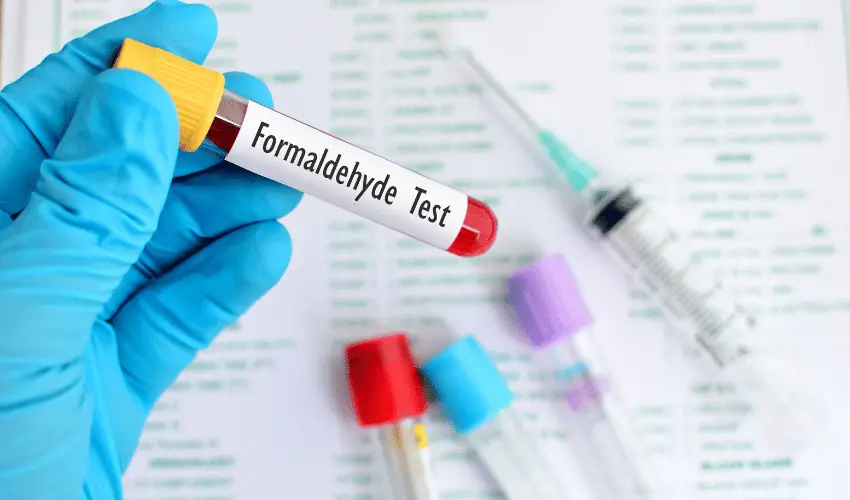
According to Occupational Safety and Health Administration (OSHA) agency, the formaldehyde exposure limit is 0.75 ppm (up to eight hours). For short-term exposure (no more than 15 minutes) the limit is set to 2 ppm.
Does Home Depot MDF have Formaldehyde?
One of the top places to purchase MDF boards in the USA is in consumer goods stores such as Home Depot. But are the boards carried by the retailer safe, or do they contain formaldehyde?
Around 2017, Home Depot announced several measures to cut down on products with harmful chemicals such as formaldehyde. To “Go Green” the retailer started working with suppliers and eco-friendly groups to find safer alternatives to such products.
If there were any products containing formaldehyde, the store would notify the customers. Furthermore, they set a limit of 0.0073 parts per million, which is lower than EPA’s 0.11 ppm, or California’s strict 0.05 ppm limit.
Therefore, if you are looking to purchase MDF boards in Home Depot, chances are you will come across several formaldehyde-free options. If not, you can check the product information for how much of the toxic substance it contains.
Does Laser Cut MDF pose a health risk?
Unless you are using an eco-friendly MDF containing no toxic materials, you can experience some health issues.
As already mentioned, most MDF boards are made using formaldehyde-based resin binders. Even in small quantities, the boards release formaldehyde gases into the surroundings.
Formaldehyde is a toxic gas that can cause a range of health effects, even in small amounts. Examples of possible effects include skin irritation, eye, ear, and throat irritation, coughing, sneezing, and more.
In large concentrations, formaldehyde is a potentially fatal chemical substance. However, even if you are not exposed to large quantities, long-term exposure to the small amounts of the gas can still lead to complications. According to several organizations, such as the American Cancer Society, long-term exposure to formaldehyde can cause cancer-related health problems.
Is It Safe to Laser Cut MDF?
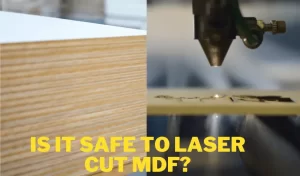
The Short Answer:
Yes, MDF can be laser cut, but only with proper ventilation and safety precautions.
The Safety Concerns:
- Toxic Fumes:
- MDF contains urea-formaldehyde resin, which can release formaldehyde gas when cut with a laser. This gas is harmful if inhaled and can irritate eyes, skin, and lungs.
- Smoke & Residue:
- Cutting MDF creates thick smoke and soot, which can quickly coat the laser’s optics and interior components.
- Fire Risk:
- Because MDF is a dense material, it can ignite easily if left in one place too long or if multiple passes overheat the board.
Do you need a mask to laser cut MDF?
What if you still want to go ahead and laser cut MDF? Can you safely cut it or do you need protective gear?
If the MDF board you are using contains formaldehyde, cutting it with a laser will release toxic fumes. Depending on where the board was manufactured, the gas fumes (and other VOCs) released could be quite substantial and toxic.
Therefore, when cutting MDF boards, it is always a great idea to wear a mask. The fumes might not reach dangerous levels, but it is better to be safe. On top of that, you should take extra precautions such as installing a fume extractor and an air filtration system.
How to Laser Cut MDF Safely
- Use Proper Ventilation or Fume Extraction:
- Always operate your laser cutter in a well-ventilated area.
- Ideally, use a dedicated exhaust system or a fume extractor with carbon filters to remove harmful gases.
- Air Assist:
- Run an air assist system to blow away debris and minimize flare-ups, which also improves cut quality.
- Keep Your Machine Clean:
- Clean the lens, mirrors, and exhaust fan regularly, especially after cutting MDF.
- Use Fire Safety Tools:
- Keep a Class ABC fire extinguisher and fire blanket nearby.
- Monitor Your Cuts:
- Never walk away while cutting MDF. Use conservative power and speed settings to avoid flare-ups.
Types of MDF for Laser Cutting
Not all MDF is created equal. Some are more laser-friendly than others.
- Standard MDF: Most common, but may contain higher levels of formaldehyde.
- Low-Formaldehyde or No-Added-Formaldehyde (NAF) MDF: Safer for laser cutting, releases fewer toxic fumes.
- MDF with Melamine or Vinyl Coatings: Avoid these types—they can release highly toxic gases.
Tip: Always check the MSDS (Material Safety Data Sheet) of your MDF to understand what’s in it.
Best MDF for Laser Cutting & Engraving
When selecting MDF (Medium Density Fiberboard) for laser cutting and engraving, choosing materials that are laser-safe, consistent in quality, and appropriate for your specific project needs is essential. Here are some top-rated MDF options available on Amazon:
MakerStock 1/8″ / 3mm MDF Sheets (12″ x 20″)
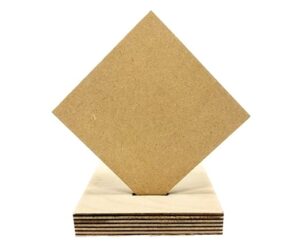
Ideal for Prototyping
These extra-refined MDF sheets are laser-safe and perfect for prototyping, signs, displays, and more. They offer a smooth surface that’s easy to sand and paint.
Generic 1/8″ MDF Draftboard Sheets (12″ x 12″, 10-Pack)
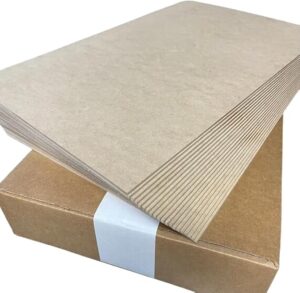
Glowforge Compatible
Specifically designed for Glowforge users, these draftboard sheets are ready for laser cutting and provide a smooth surface for intricate designs.
Trotec 1/8″ MDF Wood Sheets (23.5″ x 11.75″, 10-Pack)
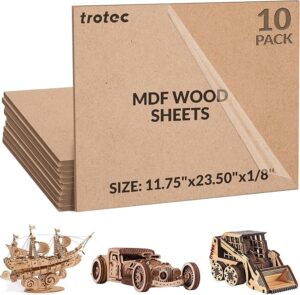
Premium Finish
Known for their exceptional surface quality, these Trotec MDF sheets are perfect for detailed laser work, offering a smooth finish ideal for painting or staining.
Tips for Choosing MDF for Laser Cutting:
- Thickness: 1/8″ (3mm) is commonly used for detailed cuts and engravings.
- Surface Quality: Look for smooth, blemish-free surfaces to ensure clean cuts and finishes.
- Laser Compatibility: Ensure the MDF is labeled as laser-safe to prevent harmful emissions or damage to your equipment.
- Sheet Size: Match the sheet dimensions to your laser cutter’s bed size for optimal use.
- Quantity: Consider bulk packs for larger projects or frequent use to save on costs.
By selecting the right MDF sheets tailored to your project’s needs, you can achieve precise and high-quality laser cuts and engravings.
What other materials can I use instead of MDF?
Worried about laser cutting MDF? You are right to be cautious. But what other alternative is there? Well, several materials offer an excellent substitute to MDF. They include:
- Formaldehyde and toxic-free eco-MDF such as the rice-stalk MDF produced in California
- Solid, natural wood
- Formaldehyde-free plywood
- Other composite woods made from agricultural fibers, for example, Ecoboard
Aside from wood materials, there are several other laser cutting materials you can consider. They include acrylic, paper, leather (natural), cardboard, etc. More information on the best materials for laser cutting and engraving can be found here.
When Not to Laser Cut MDF
- In poorly ventilated spaces without proper fume control
- On machines without air assist
- When using coated MDF or unknown brands with uncertain chemical conte
Frequently Asked Questions
Is it safe to laser cut MDF?
Yes, laser cutting MDF is generally safe if you use proper ventilation and safety equipment. MDF contains urea-formaldehyde resins, which can release toxic fumes, especially formaldehyde, when vaporized. Always use an exhaust system or fume extractor and wear appropriate PPE if working in close proximity. Never laser cut MDF in an unventilated space.
What kind of MDF is best for laser cutting?
The best MDF for laser cutting is:
Low-formaldehyde or formaldehyde-free MDF
Uncoated (avoid vinyl or melamine-coated versions)
Consistent in density and thickness
Look for MDF labeled “laser-safe” or “draftboard”, which is often pre-tested for cutting and engraving. Brands like Trotec or MakerStock are commonly used by hobbyists and professionals.
What are the typical laser settings for cutting MDF?
Settings vary by laser wattage and MDF thickness. For a 40–100W CO₂ laser, common settings for 1/8″ (3mm) MDF are:
Speed: 5–15 mm/s
Power: 60–90%
Passes: 1–2
Always run a test cut first, as some MDF sheets are denser or contain more glue than others, affecting how they cut.
Does MDF create a lot of smoke or mess?
Yes, MDF is one of the messiest materials to laser cut. It produces thick smoke, soot, and residue that can:
Coat your optics (lens and mirrors)
Clog your exhaust system
Leave burn marks on your material
Combat this by:
Using air assist
Cleaning your machine frequently
Applying transfer tape to reduce surface charring
Can MDF catch fire during laser cutting?
Yes, MDF can ignite if the laser power is too high or if you make too many passes too slowly. It’s a dense material with glue and wood fibers that can smolder or flame up. To reduce fire risk:
Never leave your laser unattended while cutting MDF
Use conservative settings
Keep a Class ABC fire extinguisher or fire blanket nearby
Ensure your air assist is on to blow away flammable particles
Final Thoughts
MDF can be a fantastic material for laser cutting, but it does require caution. By using proper safety equipment, maintaining your machine, and monitoring cuts closely, you can safely create beautiful and functional MDF projects. Always prioritize health and ventilation when working with engineered materials.
